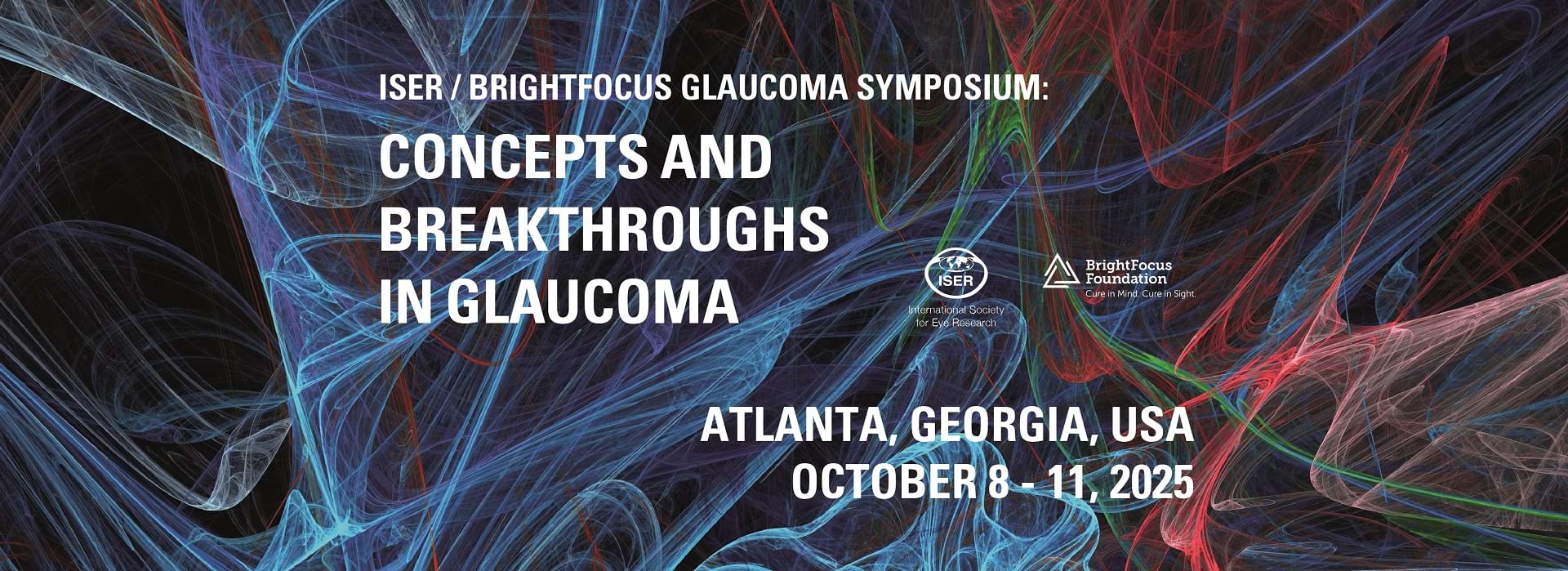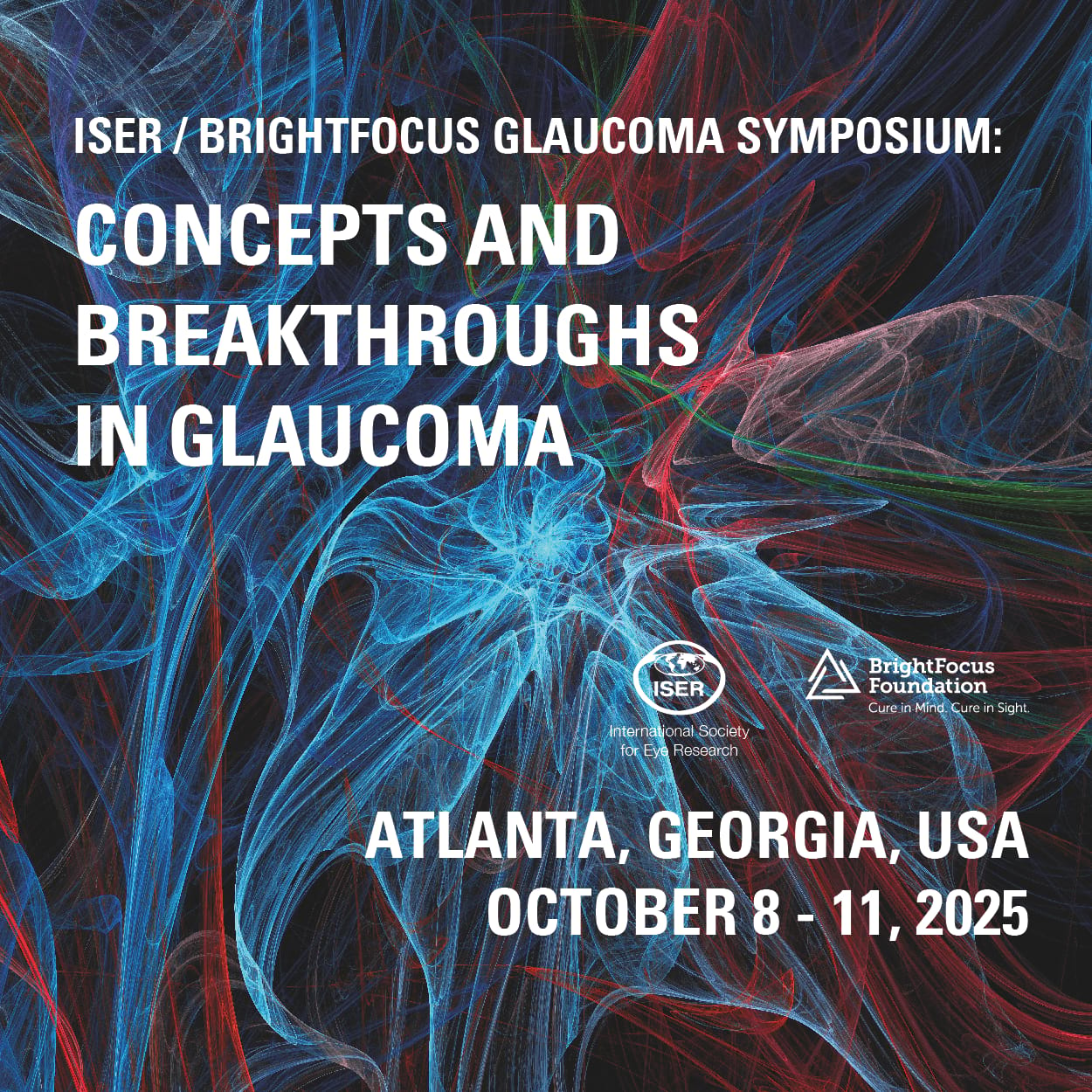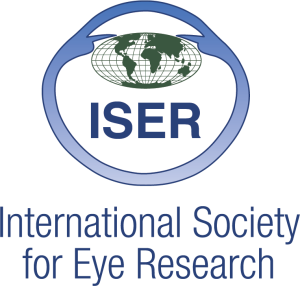Welcome from ISER and BrightFocus
It is our great pleasure to welcome you to the ISER/BrightFocus Glaucoma Symposium: Concepts and Breakthroughs in Glaucoma and BrightFocus Glaucoma Fast Track 2025!
The International Society for Eye Research (ISER) and BrightFocus Foundation have been co-sponsors of this event since 2017, cooperating in delivering scientific meetings and symposia to advance our understanding and treatment of glaucoma. We hope our collaboration, and your enthusiasm to come together to share your discoveries, continues well into the future.
As we come together, we would like to thank you all for your research in advancing the basic understanding, diagnosis and treatment of this devastating disease. Special thanks are due to the Program Organizing Committee, all of whom have spent countless hours helping to coordinate and facilitate this meeting, including: Drs. Dan Stamer, Rob Nickells, Ross Ethier, Adriana Di Polo, Abe Clark, Paloma Liton, Becky Sappington, and Colleen McDowell, as well as Drs. Diane Bovenkamp and Preeti Subramanian of BrightFocus Foundation, and Drs. Olaf Strauss and Frank Lovicu of ISER.
We also would like to thank and acknowledge our corporate sponsors who are essential to keep registration costs reasonable, as well as support travel awards and facilitate social activities.
The Mission of ISER is to provide a unique international platform for discussion and exchange of ideas on contemporary topics in eye and vision research among its members and the broader eye/vision research community. At BrightFocus, our mission is to harness the power of science to end the conditions we fear most – loss of sight and loss of mind. Through our work on glaucoma, macular degeneration, Alzheimer’s and related dementias, we are uniquely positioned for scientific innovation by enabling the sharing of discoveries from one disease to inform another.
The current meeting is built on the vibrant success of the first three meetings held on this topic which have enabled the organizers to continue to attract world authorities in glaucoma research and the clinical applications of these findings.
We welcome you to Atlanta and hope you have an enjoyable and productive meeting.

Frank Lovicu, PhD
ISER President

Diane Bovenkamp, PhD
VP Scientific Affairs
ORGANIZING COMMITTEE
Diane Bovenkamp – BrightFocus Foundation
Abbot F. Clark – University of North Texas Health Science Center at Fort Worth
Adriana Di Polo – University of Montreal
Ross Ethier – Georgia Institute of Technology & Emory University School of Medicine
Micheal Fautsch – Mayo Clinic, Rochester
Paloma Liton – Duke University
Frank Lovicu – ISER President
Colleen McDowell – University of Wisconsin-Madison
Robert Mullins – University of Iowa
Rob Nickells – University of Wisconsin – Madison
Babak N. Safa – University of South Florida
Rebecca M. Sappington – Wake Forest University School of Medicine
Daniel Stamer – Duke University
Carol Toris – Ohio State University
KEYNOTE Speakers

Anthony Khawaja, MD, PhD
Professor, UCL Institute of Ophthalmology, London, UK
Keynote Lecture:
“The complex genetics of glaucoma: biological insights and clinical prediction”
I aim to better understand and treat glaucoma using a range of data science approaches. Using large real-world data sources, I aim to understand outcomes in glaucoma care and factors which may lead to better outcomes. Using genetic data I aim to discover novel pathophysiological processes underling glaucoma and related traits. I also use our knowledge of genetic risk factors to develop prediction tools which may enable targeted glaucoma screening. Another research focus is identifying novel modifiable risk factors for glaucoma, including lifestyle factors.
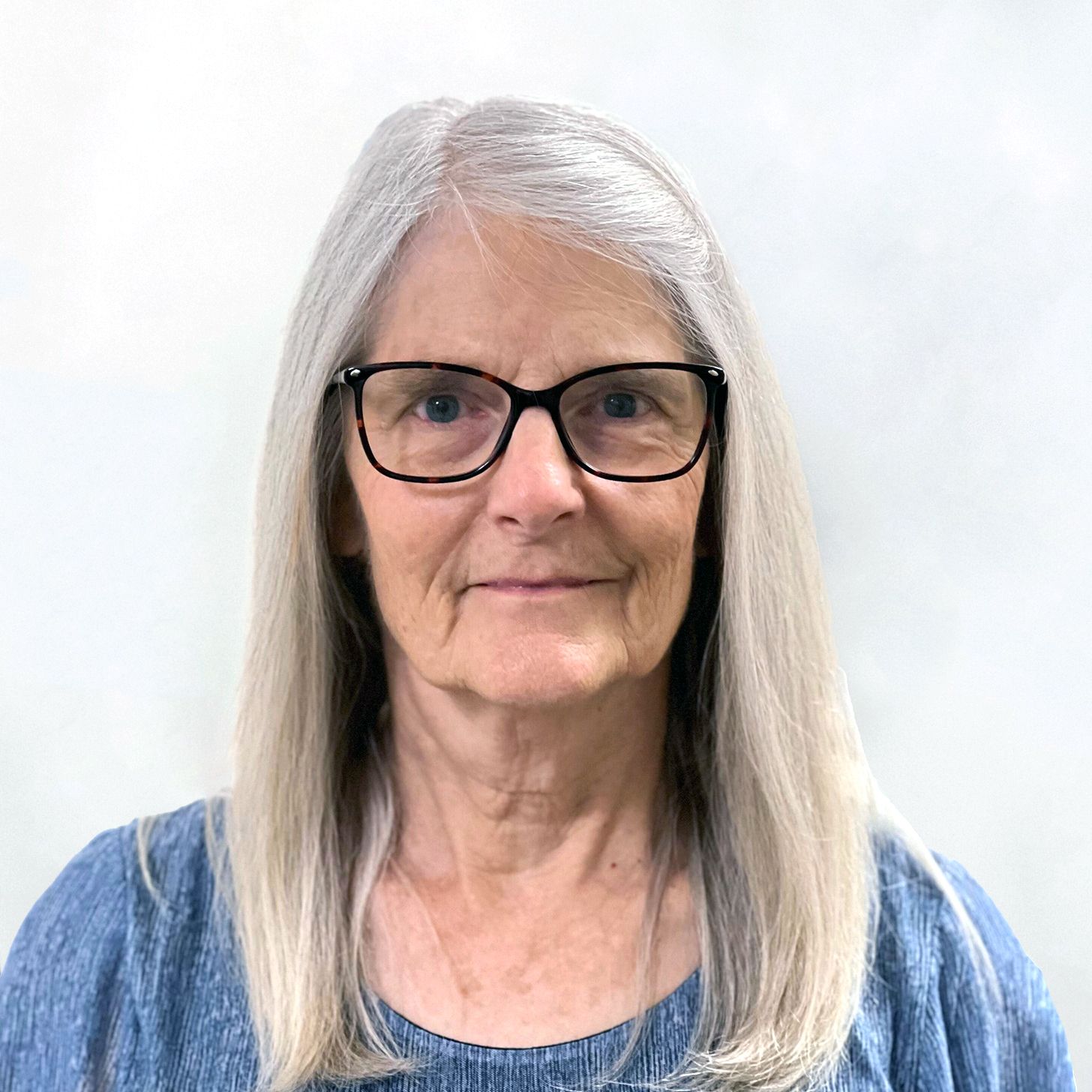
Carol Toris, PhD
Professor, The Ohio State University, USA
Keynote Lecture:
“The Ins and Outs of the Eye’s Aqueous Humor”
Carol Toris is a research professor of ophthalmology at The Ohio State University. Her primary research focus for over three decades has been and continues to be on aqueous humor dynamics (AHD) and intraocular pressure (IOP) regulation. Before joining the glaucoma research team at OSU, she worked at the University of Nebraska Medical Center for 32 years where she conducted IOP and AHD studies in cats, dogs, nonhuman primates, mice, rabbits and humans. In the primate glaucoma model, she studied a novel drainage device, many novel IOP-lowering drugs, and morphology of the outflow pathways. Her clinical research includes the study of ocular pathologies affecting IOP and normal changes that take place during aging and over a 24-hour period. She has investigated novel IOP lowering drugs when dosed alone or together, during the day and night, and under different pathological conditions. Her rabbit work included the study of ocular pathologies affecting IOP and normal changes that take place during puberty and throughout the day and night. She has studied mice with glaucoma and helped to develop a mouse fluorophotometer to measure aqueous flow. Her studies have been funded by industry in the form of collaborations or Investigator Initiated Trials, by receiving Foundation grants and by collaborations with PIs funded by NIH. This work has generated well over 300 publications, book chapters, review articles and abstracts.
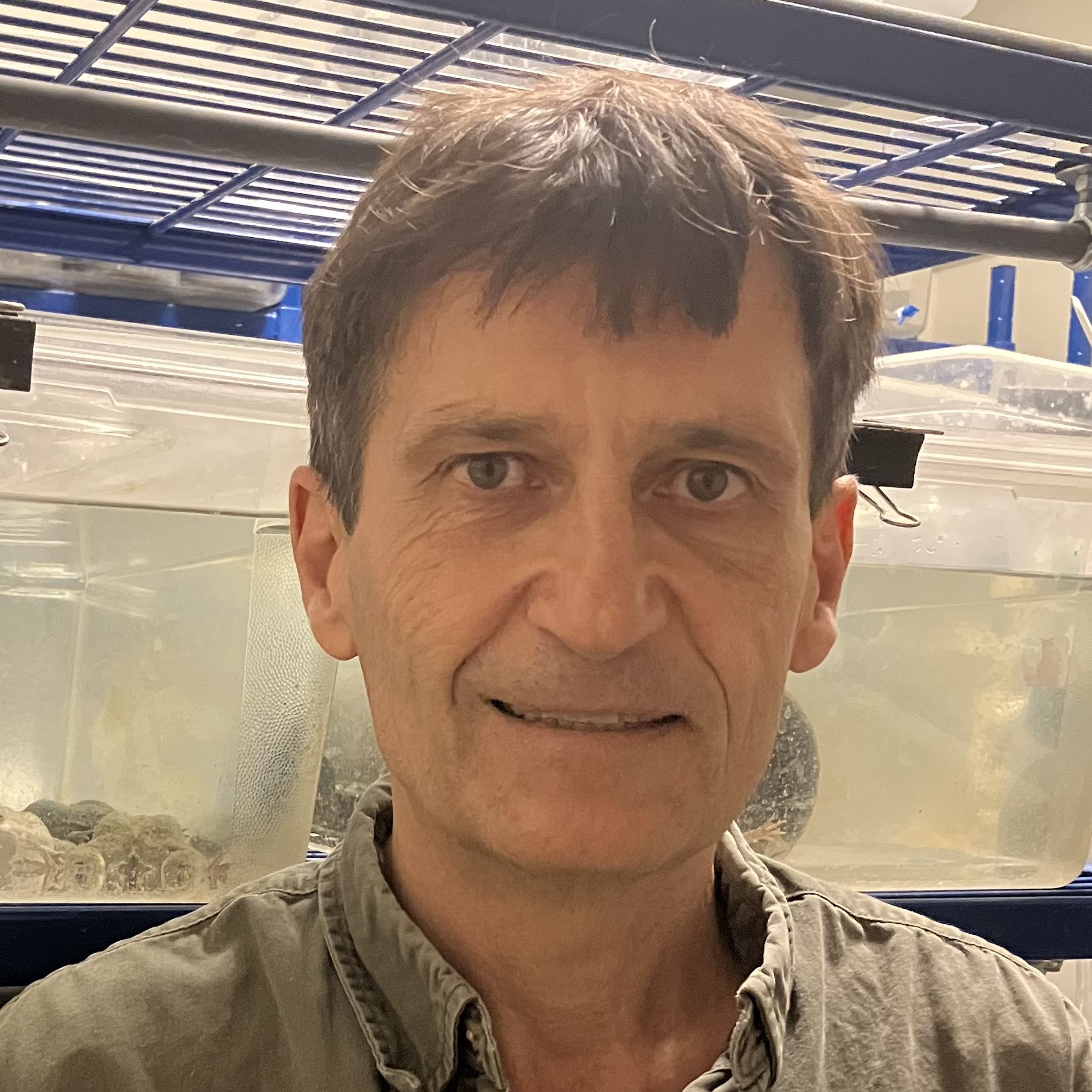
Nicholas Marsh-Armstrong, PhD
University of California Davis, USA
Keynote Lecture:
“Axonal mitochondria and the starry night“
Dr. Marsh‑Armstrong is a Professor in the Department of Ophthalmology and Vision Science at the University of California, Davis.
Dr. Marsh‑Armstrong’s laboratory investigates the cellular and molecular mechanisms underlying glaucoma, with particular emphasis on:
-Mitochondrial dysfunction in retinal ganglion cells
-The role of astrocytes in clearing debris at the optic nerve head
-The inflammatory processes that may contribute to optic nerve damage.

Shane Liddelow, PhD
Associate Professor, NYU, NY, USA
Keynote Lecture: “What is the role of reactive astrocytes in neurodegenerative disease?“
WHAT DO REACTIVE ASTROCYTES DO?
Liddelow Lab, What we do
Astrocytes are the most abundant non-neuronal cell in the mammalian central nervous system (CNS). They are integral to brain and spinal-cord physiology and perform many functions important for normal neuronal development, synapse formation, and proper propagation of action potentials. We still know very little, however, about how these functions change in response to immune attack, chronic neurodegenerative disease, or acute trauma.
Our work focuses on the mechanisms that induce different forms of the diseased, or ‘reactive’, astrocytes, and how these reactive cells interact with other cells in the CNS in a positive or negative way.
We apply this knowledge to reactive astrocytes in human disease, and believe that the discovery of astrocytes with different reactive states has important implications for the development of new therapies for CNS injury and diseases.
Ultimately, we aim to provide a more comprehensive understanding of what astrocytes do in disease and how we might ameliorate disease by targeting astrocytes.
